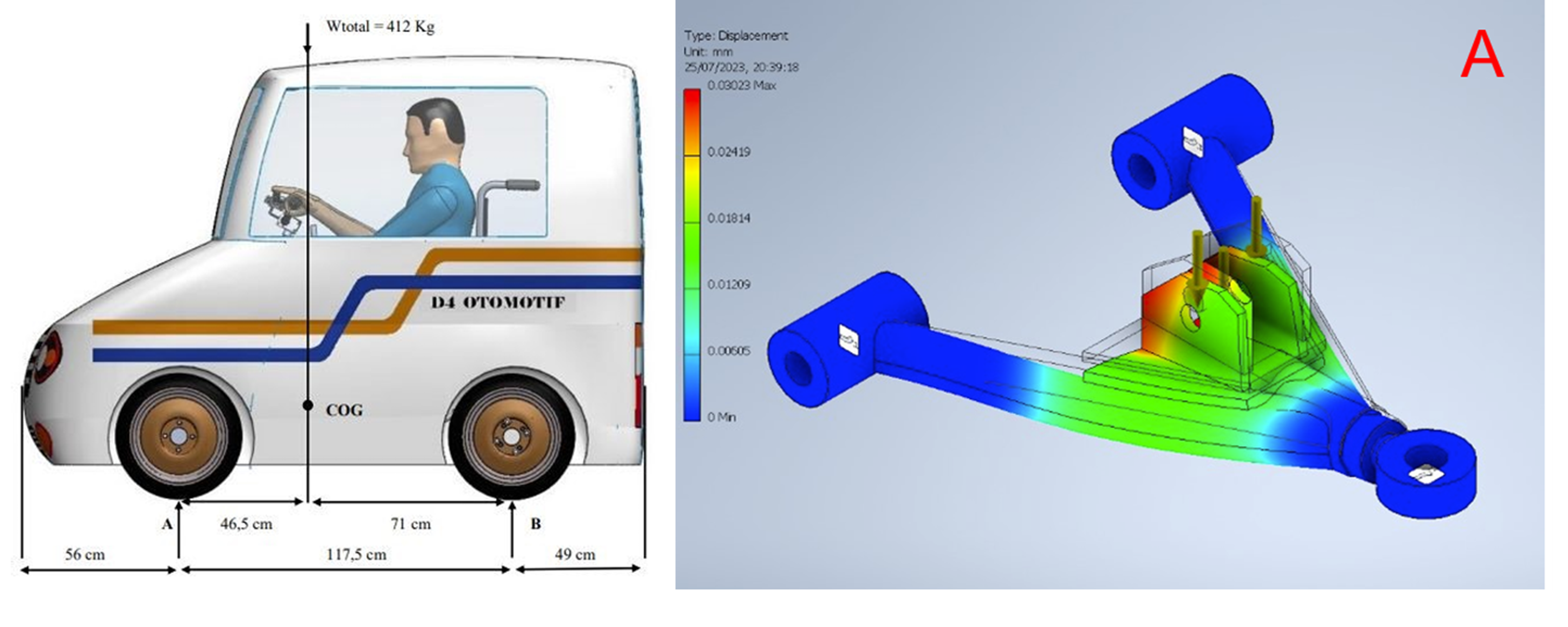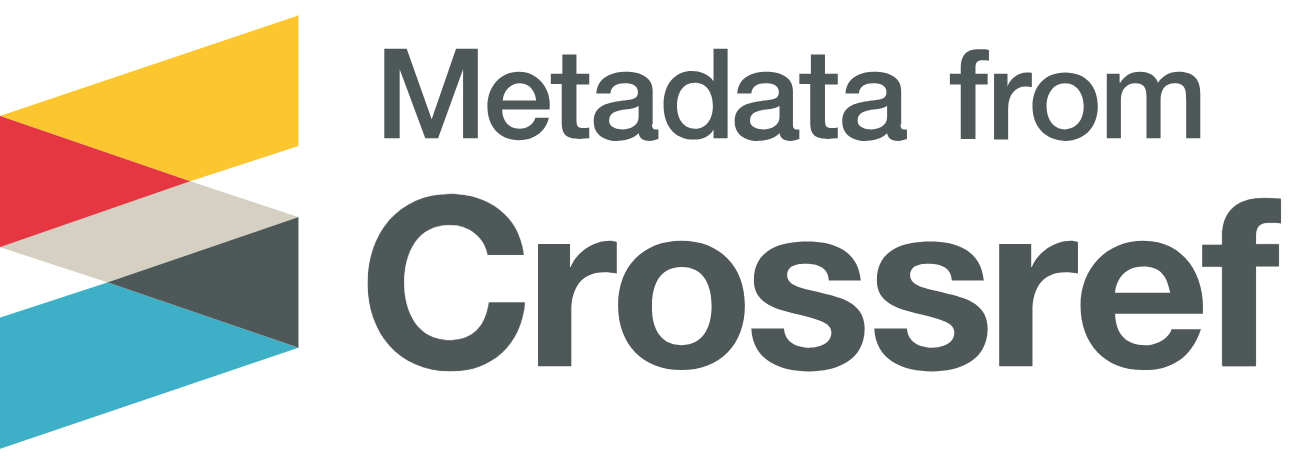Testing of Design and Functionality of Front Suspension Arm in UNY Automotive Electric Vehicle for Individuals with Disabilities
DOI:
https://doi.org/10.21831/jamat.v2i1.1276Keywords:
Safety factor, Stress, Displacement, Electric vehicleAbstract
This study aims to evaluate the design and functionality of the front suspension arm in an electric vehicle specifically designed for users with disabilities. The research focuses on the lower arm component, analyzing its structural integrity through finite element analysis using ANSYS Student Version. The simulation was conducted under two loading conditions: 1300 N and 4800 N, representing different stress scenarios based on the vehicle's weight distribution. The safety factor analysis indicates that under a 1300 N load, the lower arm achieves a safety factor of 9.37, demonstrating high structural strength. Under an increased 4800 N load, the safety factor decreases to 2.54, which remains within the acceptable range (2.5–4.0) for static components subjected to dynamic loads. In terms of stress distribution, the simulation results indicate that the maximum stress is 39.51 MPa at a load of 1300 N. In contrast, it reaches 145.9 MPa at 4800 N. The displacement analysis reveals that the maximum deformation under 1300 N is 0.03023 mm, increasing to 0.1116 mm under 4800 N, indicating minimal structural deformation. Based on these findings, the lower arm suspension is deemed structurally safe and capable of withstanding the expected operational loads. These results offer valuable insights for the development of adaptive electric vehicles, ensuring their reliability and safety for users with disabilities.
Downloads
References
[1] B. P. Resosudarmo, F. Jotzo, A. A. Yusuf, and D. A. Nurdianto, "Challenges in mitigating Indonesia’s CO2 emission: The importance of managing fossil fuel combustion," 2011, doi: 10.22004/ag.econ.249531.
[2] U. Salam, S. Lee, V. Fullerton, Y. Yusuf, S. Krantz, and M. Henstridge, "Indonesia case study: Rapid technological change–challenges and opportunities," Pathways for Prosperity Commission Background Paper Series, pp. 2019-09, 2018.
[3] D. J. Soeder, "Replacing Fossil Fuels," in Energy Futures: The Story of Fossil Fuel, Greenhouse Gas, and Climate Change: Springer, 2025, pp. 143-183.
[4] C. M. Costa, J. Barbosa, Castro, H. Castro, R. Gonçalves, and S. Lanceros-Méndez, "Electric vehicles: To what extent are environmentally friendly and cost effective?–Comparative study by european countries," Renewable and Sustainable Energy Reviews, vol. 151, p. 111548, 2021, doi: https://doi.org/10.1016/j.rser.2021.111548.
[5] S. Linton, "Reassigning meaning," in Beginning with Disability: Routledge, 2017, pp. 20-27.
[6] A. P. Kinzig et al., "Social norms and global environmental challenges: the complex interaction of behaviors, values, and policy," BioScience, vol. 63, no. 3, pp. 164-175, 2013, doi: https://doi.org/10.1525/bio.2013.63.3.5.
[7] E. A. Etukudoh, F. O. Usman, V. I. Ilojianya, C. D. Daudu, A. A. Umoh, and K. I. Ibekwe, "Mechanical engineering in automotive innovation: A review of electric vehicles and future trends," International Journal of Science and Research Archive, vol. 11, no. 1, pp. 579-589, 2024, doi: https://doi.org/10.30574/ijsra.2024.11.1.0081.
[8] F. Khan et al., "Advances of composite materials in automobile applications–A review," Journal of Engineering Research, 2024, doi: https://doi.org/10.1016/j.jer.2024.02.017.
[9] E. O. Nwulu, T. Y. Elete, K. O. Omomo, O. A. Akano, and O. V. Erhueh, "The importance of interdisciplinary collaboration for successful engineering project completions: A strategic framework," World Journal of Engineering and Technology Research, vol. 2, no. 3, pp. 48-56, 2023, doi: 10.53346/wjetr.2023.2.3.0048.
[10] D. Adriani, P. Lubis, and M. Triono, "Teaching material development of educational research methodology with Addie Models," 2020, doi: http://dx.doi.org/10.4108/eai.4-12-2019.2293793.
[11] H. Crompton et al., "Examining technology use within the ADDIE framework to develop professional training," European Journal of Training and Development, vol. 48, no. 3/4, pp. 422-454, 2024, doi: https://doi.org/10.1108/EJTD-12-2022-0137.
[12] B. E. Dicianno et al., "Systematic review: Automated vehicles and services for people with disabilities," Neuroscience letters, vol. 761, p. 136103, 2021, doi: https://doi.org/10.1016/j.neulet.2021.136103.
[13] J. F. Doyle, Static and dynamic analysis of structures: with an emphasis on mechanics and computer matrix methods. Springer Science & Business Media, 2012.
[14] C. Kennedy, "Two sources of subjectivity: Qualitative assessment and dimensional uncertainty," Inquiry, vol. 56, no. 2-3, pp. 258-277, 2013, doi: https://doi.org/10.1080/0020174X.2013.784483.
[15] A. Widyianto, A. S. Baskoro, and G. Kiswanto, "Design and Analysis of Orbital Pipe Welding Prototype for Piping System Welding Applications," Journal of Automotive and Mechanical Applied Technology, vol. 1, no. 1, pp. 11-23, 2024, doi: 10.21831/jamat.v1i1.797.
[16] N. Anuar et al., "Development of an Endurance Test Procedure for Vehicle Control Arm through Vehicle Dynamic Testing and Load Transfer Analysis," Automotive Experiences, vol. 7, no. 3, 2024, doi: https://doi.org/10.31603/ae.12561.
[17] T. Hadland, "Wheels and shock absorption," in Routledge Companion to Cycling: Routledge, 2022, pp. 108-117.
[18] S. Yadav, R. K. Mishra, V. Ansari, and S. B. Lal, "Design and analysis of steering knuckle component," Int. J. Eng. Res, vol. 4, 2016, doi: 10.23883/IJRTER.2018.4092.MYRIK.
[19] M. S. A. Pachapuri, R. G. Lingannavar, N. K. Kelageri, and K. K. Phadate, "Design and analysis of lower control arm of suspension system," Materials Today: Proceedings, vol. 47, pp. 2949-2956, 2021, doi: https://doi.org/10.1016/j.matpr.2021.05.035.
[20] Q. Li, X. Chen, T. Zhang, S. Chen, and J. Gu, "Experimental research on cage dynamic characteristics of angular contact ball bearing," Mechanics & Industry, vol. 20, no. 2, p. 204, 2019, doi: https://doi.org/10.1080/10402004.2020.1790706.

Downloads
Published
How to Cite
Issue
Section
License
Copyright (c) 2025 Journal of Automotive and Mechanical Applied Technology

This work is licensed under a Creative Commons Attribution 4.0 International License.








